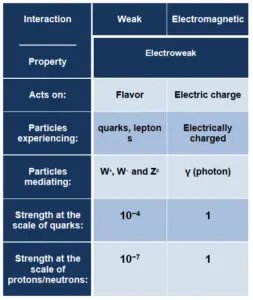Weak Interaction – Weak Force
 The weak interaction or weak force is one of the four fundamental forces and involves the exchange of the intermediate vector bosons, the W and the Z. Since these bosons are very massive (on the order of 80 GeV, the uncertainty principle dictates a range of about 10-18 meters which is less than the diameter of a proton. As a result, the weak interaction takes place only at very small, sub-atomic distances.
The weak interaction or weak force is one of the four fundamental forces and involves the exchange of the intermediate vector bosons, the W and the Z. Since these bosons are very massive (on the order of 80 GeV, the uncertainty principle dictates a range of about 10-18 meters which is less than the diameter of a proton. As a result, the weak interaction takes place only at very small, sub-atomic distances.
The weak interaction responsible for some nuclear phenomena such as beta decay, which can be understood in terms of the weak force operating on the quarks within the neutron. One of two down quarks changes into an up quark by emitting a W– boson (carries away a negative charge). The W– boson then decays into a beta particle and an antineutrino. This process is equivalent to the process, in which a neutrino interacts with a neutron.
As can be seen from the figure, the weak interaction changes one flavor of quark into another. Note that, the Standard Model counts six flavours of quarks and six flavours of leptons. The weak interaction is the only process in which a quark can change to another quark, or a lepton to another lepton (flavor change). Neither the strong interaction nor electromagnetic permit flavour changing. This fact is crucial in many decays of nuclear particles. In the fusion process, which, for example, powers the Sun, two protons interact via the weak force to form a deuterium nucleus, which reacts further to generate helium. Without the weak interaction, the diproton would decay back into two hydrogen-1 unbound protons through proton emission. As a result, the sun would not burn without it since the weak interaction causes the transmutation p -> n.
Electroweak Interaction
Although weak force is considered one of the four fundamental forces, at high energy the weak force and electromagnetic force are unified as a single electroweak force. The unification energy is on the order of 100 GeV. At low energies electromagnetic and weak interaction appear to be very different. Electroweak theory is very important for modern cosmology. In the history of the universe, during the quark epoch (shortly after the Big Bang) the unified force broke into the two separate forces as the universe cooled.
For contributions to the unification of the weak and electromagnetic interaction between elementary particles, Abdus Salam, Sheldon Glashow and Steven Weinberg were awarded the 1979 Nobel Prize in Physics.
We hope, this article, Weak Interaction – Weak Force, helps you. If so, give us a like in the sidebar. Main purpose of this website is to help the public to learn some interesting and important information about materials and their properties.
